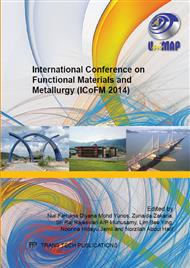[1]
S. B. Jamaludin, A. A. T. Ahmad Latiffi, K. R. Ahmad, Fazlul Bari, The influence of welding parameters and corrosive environment on the joint strength of resistance spot-welded mild steel sheets, International Journal of Mechanical and Materials Engineering. 4 (2009).
Google Scholar
[2]
S. B. Jamaludin, M. M. Noor, M. R. Ismail, K. R. Ahmad, K. Hussin, Effect of Spot Welding Current and Cycles on the Mechanical Properties of Welded Galvanized Steel Sheets, Advanced Materials Research. 795 (2013) 87-90.
DOI: 10.4028/www.scientific.net/amr.795.87
Google Scholar
[3]
Y. C. Keat, S. B. Jamaludin, Z. A. Ahmad, The effect of varying process parameters on the microhardness and microstructure of Cu-Steel and Al-Al2O3 friction joints, Jurnal Teknologi. 41(2004) 85-95.
DOI: 10.11113/jt.v41.693
Google Scholar
[4]
S. Kou, Welding Metallurgy, 2nd edition, John Wiley & Sons, Inc, (2003).
Google Scholar
[5]
M. M. Noor, A. Tan, Y. Zhen, S. B. Jamaludin, N. F. Hayazi, S. R. Shamsudin, Joining of Dissimilar 6063 Aluminium Alloy–316L Stainless Steel by Spot Welding: Tensile Shear Strength and Heat Treatment, Advanced Materials Research. 796 (2013).
DOI: 10.4028/www.scientific.net/amr.795.492
Google Scholar
[6]
S. B. Jamaludin, M. M. Noor, S. K. A. Kadir, K. R. Ahmad, Mechanical Properties of Dissimilar Welds between Stainless Steel and Mild Steel, Advanced Materials Research. 795 (2013) pp.74-77.
DOI: 10.4028/www.scientific.net/amr.795.74
Google Scholar
[7]
R. Borrisuttheku, T. Yachi, Y. Miyashita, Y. Mutoh, Suppression of intermetallic reaction layer formation by controlling heat flow in dissimilar joining of steel and aluminum alloy, Mater. Sci. Eng. A. 467 (2007) 108-113.
DOI: 10.1016/j.msea.2007.03.049
Google Scholar
[8]
K. J. Lee, S. Kumai, Characterization of intermetallic compound layer formed at the weld interface of the defocused laser welded low carbon steel/6111 aluminum alloy lap joint. Mater. Trans., 47 (2006) 1178-1185.
DOI: 10.2320/matertrans.47.1178
Google Scholar
[9]
R. Borrisuttheku, P. Mitsomwang, S. Rattanachan, Y. Mutoh, Feasibility of Using TIG Welding in Dissimilar Metals between Steel/Aluminum Alloy, Energy Research Journal. 1 (2010) 82-86.
DOI: 10.3844/erjsp.2010.82.86
Google Scholar
[10]
S. Kobayashi, T. Yakou, Control of intermetallic compound layers at interface between steel and aluminum by diffusion-treatment, Materials Science and Engineering A338 (2002) 44-53.
DOI: 10.1016/s0921-5093(02)00053-9
Google Scholar


